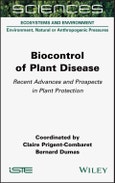Faced with climate changes, pest pressure on plants is increasing and new pest complexes are appearing, for which plant protection solutions are not yet available. The reduction of anthropic pressure on agroecosystems requires a reduction in the use of chemical inputs and the promotion of biocontrol approaches.
In this book, we present new advances on plant disease management that are emerging from research outputs. The ability of biocontrol products to directly (e.g. production of antimicrobial peptides or quorum quenching activities by microorganisms, use of plant or agro-industrial by-products as biopesticides, etc.) or indirectly (e.g. via the increase of plant defense or plant growth pathways) protect plants against pathogens and pests is also considered.
We also address new strategies like the development of phage-based biocontrol products and those that consider the plant as a holobiont and plant microbiota as targets of biocontrol treatments. The important question of the current regulatory process needed to launch plant production products on the market is also addressed, such as methods to evaluate their environmental impact.
Table of Contents
Introduction xi
Bernard DUMAS and Claire PRIGENT-COMBARET
Chapter 1 Regulatory Aspects of Biocontrol 1
Diane ROBIN, Léa MERLET and Patrice MARCHAND
1.1 Regulatory definition of biocontrol 2
1.2 Current issues and limitations 3
1.3 A mixed evolution 5
1.4 Necessary evolutions 12
1.5 Conclusion 13
1.6 References 14
Chapter 2 Biological Controls in Horticulture 19
Nicolas GUIBERT, Maïder SAINT JEAN, Claire PRIGENT-COMBARET, Jean-Marc DEOGRATIAS, Cécile CABASSON and Pierre PÉTRIACQ
2.1 Introduction 19
2.2 Biological controls in horticulture 24
2.3 Physiological trade-offs for growth and immunity 26
2.4 Eco-innovations and economic trade-offs 28
2.5 Challenges and perspectives 36
2.6 Concluding remarks 38
2.7 References 39
Chapter 3 Development of Omics Tools for the Assessments of the Environmental Fate and Impact of Biocontrol Agents 47
Hikmat GHOSSON, Marie-Virginie SALVIA and Cédric BERTRAND
3.1 Introduction: emergence of biocontrol agents and their risks 48
3.2 Evaluation methodologies: an overview 49
3.3 Limitations of classic methodologies 50
3.4 Omics: potential tools for risks assessment? 52
3.5 Perspectives 62
3.6 List of abbreviations 63
3.7 Acknowledgments 64
3.8 References 65
Chapter 4 Plant Secondary Metabolites Mode of Action in the Control of Root-Knot Nematodes 75
Nikoletta NTALLI and Pierluigi CABONI
4.1 Introduction 76
4.2 Recent research on the use of plant secondary metabolites to control Meloidogyne spp 77
4.3 Conclusion 83
4.4 References 83
Chapter 5 Agro-industrial By-products and Waste as Sources of Biopesticides 91
Maria Fe ANDRES and Azucena GONZÁLEZ COLOMA
5.1 Introduction 91
5.2 Biopesticidal properties of pyrolysis products from agro-industrial waste 93
5.3 Biopesticidal properties of hydrolates: by-products of essential oil distillation 99
5.4 Biopesticidal properties of olive oil mill waste 103
5.5 Conclusion and future directives 105
5.6 Acknowledgments 107
5.7 References 107
Chapter 6 Antimicrobial and Defense Elicitor Peptides as Biopesticides for Plant Disease Control 121
Emilio MONTESINOS, Esther BADOSA, Maria PLA, Laura MONTESINOS and Anna BONATERRA
6.1 Introduction 122
6.2 Peptides of microbial origin 124
6.3 Peptides from plants 130
6.4 Peptides from animals 134
6.5 Synthetic peptides 138
6.6 Biotechnological production of peptides 142
6.7 References 145
Chapter 7 Biocontrol of Plant Pathogens via Quorum Quenching 159
Denis FAURE and Xavier LATOUR
7.1 Quorum quenching to counteract quorum sensing 159
7.2 Quorum sensing inhibitors 160
7.3 Quorum quenching enzymes 161
7.4 Quorum quenching biocontrol agents 162
7.5 Monitoring of quorum quenching biocontrol agents and activities 163
7.6 Biostimulation of quorum quenching 164
7.7 Management of quorum quenching treatments 165
7.8 Quorum quenching in biocontrol: perspectives 166
7.9 Acknowledgments 166
7.10 References 167
Chapter 8 Phage-mediated Biocontrol Against Plant Pathogenic Bacteria 173
Fernando CLAVIJO-COPPENS, Clara TORRES-BARCELO, Mireille ANSALDI, Nicolas TAVEAU and Denis COSTECHAREYRE
8.1 Introduction 174
8.2 Bacteriophages for plant health 179
8.3 Phage-based biocontrol regulations 199
8.4 Conclusions and perspectives 201
8.5 Acknowledgments 203
8.6 References 203
Chapter 9 Microbiome-assisted Agriculture: Current Knowledge and Future Directions 217
Ke YU, Hongwei LIU, Wei ZHONG and Ioannis A STRINGLIS
9.1 Introduction 217
9.2 Microbiome-mediated benefits for plants 221
9.3 Chemical cues derived from plants and microbes guide microbiome assembly 225
9.4 Plant and soil microbiome engineering 232
9.5 Concluding remarks and future perspectives 238
9.6 References 239
List of Authors 255
Index 259








